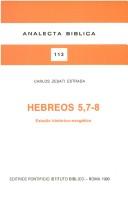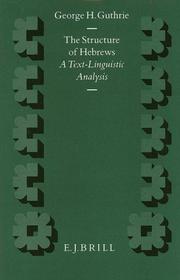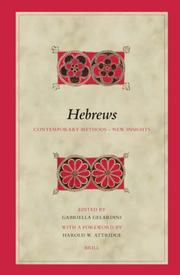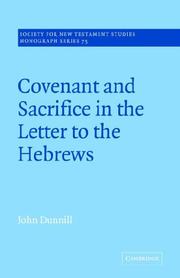| Listing 1 - 10 of 20 | << page >> |
Sort by
|
Book
ISBN: 9122012516 9789122012511 Year: 1989 Volume: 21 Publisher: Stockholm Almqvist & Wiksell International
Abstract | Keywords | Export | Availability | Bookmark
 Loading...
Loading...Choose an application
- Reference Manager
- EndNote
- RefWorks (Direct export to RefWorks)
Book
ISBN: 9789042933224 9042933224 Year: 2016 Volume: 85 Publisher: Leuven Paris Bristol, CT Peeters
Abstract | Keywords | Export | Availability | Bookmark
 Loading...
Loading...Choose an application
- Reference Manager
- EndNote
- RefWorks (Direct export to RefWorks)
This volume contains the exegetical contributions of a conference held in Louvain-la-Neuve in 2014. The participants explored the concepts of border, boundary, and frontier related to Hebrews, not only in the letter itself, but also in its reception. The book first focuses on the definition of Hebrews as a text at the confluence of various cultural worlds : elaborated in the Diaspora, can the letter/sermon be characterized as a middle course between a so-called 'Jewish world' and a so-called 'pagan world'? Within the Jewish cultural world, did it really hold a marginal position? Is its nuanced attitude toward the priesthood and the Temple the first step outside Judaism, as it has long been claimed ?

ISBN: 8876531130 9788876531132 Year: 1990 Volume: 113 Publisher: Rome Biblical Institute Press
Abstract | Keywords | Export | Availability | Bookmark
 Loading...
Loading...Choose an application
- Reference Manager
- EndNote
- RefWorks (Direct export to RefWorks)
Bible --- Criticism, interpretation, etc --- 227.1*9 --- Brief van Paulus aan de Hebreeën --- 227.1*9 Brief van Paulus aan de Hebreeën --- Bible. --- Criticism, interpretation, etc. --- Bible. N.T. Hebrews
Book
ISBN: 9071680126 Year: 1990 Volume: vol *13 Publisher: Mechelen Leuven Werkgroep Sacerdos Vlaamse Bijbelstichting
Abstract | Keywords | Export | Availability | Bookmark
 Loading...
Loading...Choose an application
- Reference Manager
- EndNote
- RefWorks (Direct export to RefWorks)
Nieuwe Testament --- Nouveau Testament --- 227.1*9 --- 227*2 --- 227.1*8 --- #gsdb12 --- Brief van Paulus aan de Hebreeën --- Katholieke brieven --- Pastorale brieven. Brieven van Paulus aan Timotheus. Brief aan Titus --- 227.1*8 Pastorale brieven. Brieven van Paulus aan Timotheus. Brief aan Titus --- 227*2 Katholieke brieven --- 227.1*9 Brief van Paulus aan de Hebreeën --- Pastores, liturgisch en Bijbel-geïnteresseerden
Book
ISBN: 9789004311688 9789004311695 Year: 2016 Volume: 91 Publisher: Leiden ; Boston Koninklijke Brill NV
Abstract | Keywords | Export | Availability | Bookmark
 Loading...
Loading...Choose an application
- Reference Manager
- EndNote
- RefWorks (Direct export to RefWorks)
227.1*9 --- Brief van Paulus aan de Hebreeën --- Bible. --- Epistle to the Hebrews --- Hebräerbrief (Book of the New Testament) --- Hebrews (Book of the New Testament) --- Poslanie do Evreite (Book of the New Testament) --- Risālah ilá al-ʻIbrānīyīn (Book of the New Testament) --- Criticism, interpretation, etc. --- 227.1*9 Brief van Paulus aan de Hebreeën
Book
ISBN: 9781108554763 9781108429467 9781108454261 1108429467 1108554768 1108665845 110869831X Year: 2018 Volume: 171 Publisher: Cambridge Cambridge University Press
Abstract | Keywords | Export | Availability | Bookmark
 Loading...
Loading...Choose an application
- Reference Manager
- EndNote
- RefWorks (Direct export to RefWorks)
Inventing Hebrews examines a perennial topic in the study of the Letter to the Hebrews, its structure and purpose. Michael Wade Martin and Jason A. Whitlark undertake at thorough synthesis of the ancient theory of invention and arrangement, providing a new account of Hebrews' design. The key to the speech's outline, the authors argue, is in its use of 'disjointed' arrangement, a template ubiquitous in antiquity but little discussed in modern biblical studies. This method of arrangement accounts for the long-observed pattern of alternating epideictic and deliberative units in Hebrews as blocks of narratio and argumentatiorespectively. Thus the 'letter' may be seen as a conventional speech arranged according to the expectations of ancient rhetoric (exordium, narratio, argumentatio, peroratio), with epideictic comparisons of old and new covenant representatives (narratio) repeatedly enlisted in amplification of what may be viewed as the central argument of the speech (argumentatio), the recurring deliberative summons for perseverance. Resolving a long-standing conundrum, this volume offers a hermeneutical tool necessary for interpreting Hebrews, as well as countless other speeches fro
227.1*9 --- 227.1*9 Brief van Paulus aan de Hebreeën --- Brief van Paulus aan de Hebreeën --- Bible. --- Epistle to the Hebrews --- Hebräerbrief (Book of the New Testament) --- Hebrews (Book of the New Testament) --- Poslanie do Evreite (Book of the New Testament) --- Risālah ilá al-ʻIbrānīyīn (Book of the New Testament) --- Criticism, interpretation, etc. --- Bible --- Criticism, interpretation, etc
Book
ISSN: 01679732 ISBN: 9789004460164 9789004460171 9004460160 9004460179 Year: 2021 Volume: 184 Publisher: Leiden Boston Brill
Abstract | Keywords | Export | Availability | Bookmark
 Loading...
Loading...Choose an application
- Reference Manager
- EndNote
- RefWorks (Direct export to RefWorks)
In the collection entitled Deciphering the Worlds of Hebrews Gabriella Gelardini gathers fifteen essays written in the last fifteen years, twelve of which are in English and three in German. Arranged in three parts (the world of, behind, and in front of Hebrews's text), her articles deal with such topics as structure and intertext, sin and faith, atonement and cult, as well as space and resistance. She reads Hebrews no longer as the enigmatic and homeless outsider within the New Testament corpus, as the "Melchizedekian being without genealogy"; rather, she reads Hebrews as one whose origin has finally been rediscovered, namely in Second Temple Judaism
Bible. --- Criticism, interpretation, etc. --- Bible --- New Testament --- 227.1*9 --- 227.1*9 Brief van Paulus aan de Hebreeën --- Brief van Paulus aan de Hebreeën --- Epistle to the Hebrews --- Hebräerbrief (Book of the New Testament) --- Hebrews (Book of the New Testament) --- Poslanie do Evreite (Book of the New Testament) --- Risālah ilá al-ʻIbrānīyīn (Book of the New Testament)

ISBN: 9004098666 9004267069 9789004267060 9789004098664 Year: 1994 Volume: 73 Publisher: Leiden [The Netherlands] ; New York : E.J. Brill,
Abstract | Keywords | Export | Availability | Bookmark
 Loading...
Loading...Choose an application
- Reference Manager
- EndNote
- RefWorks (Direct export to RefWorks)
One of the focal issues surrounding contemporary studies of Hebrews concerns the book's elusive structure. This volume presents an examination of previous proposals and a fresh attempt at unlocking Hebrews' organizational principles. The first part of the volume critically assesses past efforts at outlining Hebrews. Following a history of investigation, the various approaches to the structure of Hebrews are categorized and evaluated for both strengths and weaknesses. Methodologies considered include thematic analysis, literary analysis, rhetorical analysis, and linguistic analysis. Part two of the volume offers a texts-linguistic analysis of Hebrews, utilizing both modern linguistic theory and insight into ancient oratorical conventions. This book presents advances in text-linguistic analysis and a compelling proposal concerning the structure of Hebrews.
Bible. N.T. Hebrews --- Bible. --- Criticism, interpretation, etc --- Critique, interprétation, etc. --- Bible --- 227.1*9 --- Brief van Paulus aan de Hebreeën --- 227.1*9 Brief van Paulus aan de Hebreeën --- Critique, interprétation, etc. --- Epistle to the Hebrews --- Hebräerbrief (Book of the New Testament) --- Hebrews (Book of the New Testament) --- Poslanie do Evreite (Book of the New Testament) --- Risālah ilá al-ʻIbrānīyīn (Book of the New Testament) --- Criticism, interpretation, etc.

ISBN: 9004144900 9789004144903 9789047407928 904740792X 1433707918 9781433707919 1280868422 9781280868429 9786610868421 Year: 2005 Volume: 75 Publisher: Leiden Boston Brill
Abstract | Keywords | Export | Availability | Bookmark
 Loading...
Loading...Choose an application
- Reference Manager
- EndNote
- RefWorks (Direct export to RefWorks)
The present volume contains a collection of fourteen essays applying the latest and neglected methods and offering new and innovative insights into the interpretation of the New Testament book To the Hebrews. The excitingly diverse contributions, which stem from an intriguing international group of senior and younger Hebrews, New Testament, and Old Testament scholars, are presented in three parts: Part One focuses on cultic language, concepts, and practice in Hebrews; Part Two on sociology, ethics, and rhetoric in Hebrews; and Part Three on textual-historical, comparative, and intertextual approaches to Hebrews. As the first ever compilation of essays on Hebrews by a range of authors, this volume presents an important contribution to the field of New Testament studies. It will particularly appeal to students, teachers, and scholars interested in a variety of critical perspectives on Hebrews and on the New Testament's third great theologian next to Paul and John. Moreover, the treatment of hermeneutical, cultic, sociological, and comparative matters in the context of biblical, Greco-Roman, and rabbinic literature will make this collection valuable to an even broader readership.
227.1*9 --- 227.1*9 Brief van Paulus aan de Hebreeën --- Brief van Paulus aan de Hebreeën --- Bible. --- Epistle to the Hebrews --- Hebräerbrief (Book of the New Testament) --- Hebrews (Book of the New Testament) --- Poslanie do Evreite (Book of the New Testament) --- Risālah ilá al-ʻIbrānīyīn (Book of the New Testament) --- Criticism, interpretation, etc. --- Hebrews (Book of the Bible) --- Bible --- Criticism, interpretation, etc

ISBN: 0521431581 052102062X 0511554923 0511881843 9780521431583 9780511554926 9780521020626 Year: 1992 Volume: 75 Publisher: Cambridge Cambridge University Press
Abstract | Keywords | Export | Availability | Bookmark
 Loading...
Loading...Choose an application
- Reference Manager
- EndNote
- RefWorks (Direct export to RefWorks)
Among the problems which Hebrews poses for interpretation, its use of sacrificial terminology must cause it to seem remote and obscure. Although the recent work of social anthropologists on the nature of religious systems has been applied by Old Testament scholars to the laws and symbols of the Pentateuch this is the first sustained study of Hebrews to take account of these theories. Building on the work of such writers as Mary Douglas, Victor Turner, and Claude Lévi-Strauss, Hebrews is approached here as a 'structure of symbols', in which the symbol-system of the Old Testament covenant is re-presented and transposed. Motifs explored by the author include sacred time and space; liminality; the sacrificial function of blood, death, oaths, and blessings; and the narrative traditions of election and exclusion. Dr Dunnill assesses Hebrews, not as an argument, but as an act of symbolic communication expressing the possibility of direct communion with God.
Covenants --- Sacrifice --- Religious aspects. --- Religious aspects --- Judaism. --- Christianity. --- 227.1*9 --- -Sacrifice --- -Covenants --- -Agreements --- Burnt offering --- Worship --- Brief van Paulus aan de Hebreeën --- Christianity --- -Judaism --- -Brief van Paulus aan de Hebreeën --- 227.1*9 Brief van Paulus aan de Hebreeën --- -227.1*9 Brief van Paulus aan de Hebreeën --- Agreements --- Covenants (Religion) --- Religious aspects&delete& --- Judaism --- Bible. --- Epistle to the Hebrews --- Hebräerbrief (Book of the New Testament) --- Hebrews (Book of the New Testament) --- Poslanie do Evreite (Book of the New Testament) --- Risālah ilá al-ʻIbrānīyīn (Book of the New Testament) --- Criticism, interpretation, etc. --- Bible. N.T. Hebrews --- Criticism, interpretation, etc --- Covenants (Jewish theology) --- Arts and Humanities --- Religion --- Covenants - Religious aspects. --- Covenants - Religious aspects - Judaism. --- Sacrifice - Christianity.
| Listing 1 - 10 of 20 | << page >> |
Sort by
|

 Search
Search Feedback
Feedback About UniCat
About UniCat  Help
Help News
News